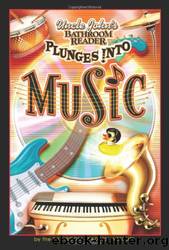Uncle Johnâs Bathroom Reader Plunges into Music by Bathroom Readers’ Institute

Author:Bathroom Readers’ Institute
Language: eng
Format: epub
Publisher: Bathroom Readers’ Press
Published: 2013-02-20T18:59:40+00:00
More than 50% of S. Koreaâs music sales are in the form of downloadsâthe most of any country.
ELECTRIFIED
The harmonica went into decline in the 1950s, but bluesmen like Little Walter, Howlinâ Wolf, and Sonny Boy Williamson kept it alive, creating a modern blues-harp sound that would be carried on by James Cotton and Charlie Musselwhite. By the 1960s, the harmonica was back, thanks first to the folk music craze and then to Beatlemania.
Since then, harmonica players like Stevie Wonder, John Mayall, Huey Lewis, Delbert McClinton, Magic Dick (J. Geils Band), Neil Young, Bruce Springsteen, Charlie McCoy, Mickey Rafael (Willie Nelsonâs band), and John Popper (Blues Traveler) continue to show the world what one little instrument can do.
HARMONICA TRIVIA
⢠Nicknames for the harmonica: the Harp, the Tin Sandwich (Cowboy dialect), the Mississippi Saxophone (Blues lingo), and the Mouth Organ (from the German mundharmonika or mundorgan).
⢠Presidents Lincoln, Wilson, Coolidge, and Reagan were all harp players of varying ability. Lincoln reportedly wrote a letter to Hohner, telling how he enjoyed playing the harmonica to relax.
⢠The best-selling record of 1947 was âPeg Oâ My Heartâ by a harmonica trio called the Harmonicats. After the Harmonicatsâ success, the musicians union decided to classify the harmonica as an instrument. Before that, they called it a toy.
⢠On December 16, 1965, astronaut Wally Schirra played âJingle Bellsâ on the harmonicaâfrom Gemini VI, at an altitude of 160 miles above Earth.
⢠In 1986 the M. Hohner Company sold their billionth harmonica.
⢠Currently, the most expensive harmonica in the Hohner catalog is a âChord 48â (the size of a baseball bat, with hundreds of reeds). Cost: $1,500.
⢠More expensive, but not in the catalog: the solid gold, gemencrusted model that Hohner presented to Pope Pius XI in the 1930s.
Download
This site does not store any files on its server. We only index and link to content provided by other sites. Please contact the content providers to delete copyright contents if any and email us, we'll remove relevant links or contents immediately.
| Biographies | Business |
| History & Criticism | Instruments |
| Musical Genres | Recording & Sound |
| Reference | Songbooks |
| Theory, Composition & Performance |
The Goal (Off-Campus #4) by Elle Kennedy(12450)
Kathy Andrews Collection by Kathy Andrews(10559)
Diary of a Player by Brad Paisley(6872)
What Does This Button Do? by Bruce Dickinson(5537)
Assassin’s Fate by Robin Hobb(5256)
Big Little Lies by Liane Moriarty(4892)
Pale Blue Dot by Carl Sagan(4018)
Sticky Fingers by Joe Hagan(3459)
The Heroin Diaries by Nikki Sixx(2942)
The Death of the Heart by Elizabeth Bowen(2910)
Beneath These Shadows by Meghan March(2730)
The Help by Kathryn Stockett(2709)
Confessions of a Video Vixen by Karrine Steffans(2682)
How Music Works by David Byrne(2539)
Jam by Jam (epub)(2496)
Harry Potter 4 - Harry Potter and The Goblet of Fire by J.K.Rowling(2422)
Strange Fascination: David Bowie: The Definitive Story by David Buckley(2371)
Petty: The Biography by Warren Zanes(2241)
Darker Than the Deepest Sea by Trevor Dann(2214)
